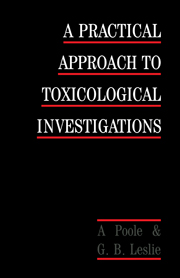Book contents
- Frontmatter
- Contents
- Foreword
- Preface
- List of abbreviations
- 1 Introduction
- 2 Regulatory requirements
- 3 Animals: sources, selection, husbandry
- 4 Standard studies in animals
- 5 Measurements and observations made in living animals
- 6 Terminal studies
- 7 Specialised routes of exposure
- 8 Reproductive toxicology
- 9 Genotoxicity
- Appendix 1 Toxicology data requirements for clinical trial approval and registration of new drugs
- Appendix 2 Countries and addresses of regulatory agencies
- Index
3 - Animals: sources, selection, husbandry
Published online by Cambridge University Press: 04 August 2010
- Frontmatter
- Contents
- Foreword
- Preface
- List of abbreviations
- 1 Introduction
- 2 Regulatory requirements
- 3 Animals: sources, selection, husbandry
- 4 Standard studies in animals
- 5 Measurements and observations made in living animals
- 6 Terminal studies
- 7 Specialised routes of exposure
- 8 Reproductive toxicology
- 9 Genotoxicity
- Appendix 1 Toxicology data requirements for clinical trial approval and registration of new drugs
- Appendix 2 Countries and addresses of regulatory agencies
- Index
Summary
Before toxicological studies can begin, experimental animals must be obtained (usually from commercial suppliers), acclimatised, checked for general health (possibly including blood tests), allocated to groups, numbered, labelled, caged and fed. The overall objective is to select and maintain animals in the best possible conditions of health throughout the course of a study. This is done for both humane reasons and also to provide the maximum opportunity for detecting and investigating adverse effects. It is also essential to minimise variables in the animals' environment which can influence the development of pathological changes. The importance of environmental conditions was demonstrated by Riley (1975) who reported that mice in a noisy environment developed mammary tumours much earlier than their siblings kept in quiet surroundings. The methods for achieving these objectives, i.e. maintaining healthy animals in a well controlled and standardised environment, can vary depending on the species being used.
RATS AND MICE
Rats and mice of various well-known strains, bred to very high standards, are now readily obtainable from a number of large Rats and mice 31 commercial breeders some of which are multinational. Thus while a few organisations breed their own animals, the majority purchase them from commercial suppliers as and when required. The most widely used strains of rat in the UK are Sprague–Dawley and Wistar, the latter is a slightly smaller animal which may offer an advantage for some studies.
- Type
- Chapter
- Information
- A Practical Approach to Toxicological Investigations , pp. 30 - 43Publisher: Cambridge University PressPrint publication year: 1989



